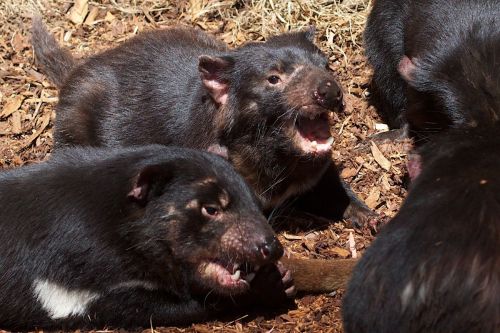They mainly inhabit aquatic environments where they live on the seafloor (a record-breaker has been found at a depth of 10.5 km) or float in the depths as plankton. Some have also colonized land, although some terrestrial crustaceans must return to the water for procreation.
They are the fourth most abundant group of invertebrates in terms of species, only insects, arachnids, and mollusks being more numerous.
To date, about 67.000 species of these animals have been described.
Crabs and shrimps did not appear until the Jurassic (201 - 145 million years ago) and lobsters appeared in the Cretaceous (145 - 66 million years ago).
Terrestrial crustaceans mainly include centipedes, some crabs, and hermit crabs.
When crustaceans grow they must undergo moulting, they then go to a safe place where they shed their outer carapace after which they quickly increase in size before the next carapace hardens.
In comparison, arachnids have no sensilla at all, and insects only have one pair.
Some crustaceans have a head torso and abdomen, but there are some in which it is impossible to distinguish these elements. In this case, the structure of their body is divided into head and body.
Lungs are found in crabs Chasmagnathus granulatus and hermit crabs Coenobita and Birgus. They are made of similar tissues as gills but are more adapted to breathing atmospheric air. Terrestrial hermit crabs have gills in addition to lungs, but they are too inefficient to allow them to breathe underwater so these crabs can easily drown even in shallow water.
Most are scavengers but some are carnivores, some are herbivores, and still others are filter feeders or parasites. The prey of parasitic crustaceans is usually fish, whales, or other crustaceans.
In crustaceans, internal fertilization occurs. Most aquatic crustaceans guard their eggs and carry them with them on their legs, in body cavities or nesting bags until they hatch, while others simply attach them to rocks or release the fertilized eggs into the watery depths.
Some crustaceans hatch in an adult-like form and grow with successive moulting (epimorphosis). Others hatch as a larva and produce successive body segments with each moulting (anamorphosis) and still others, as in insects, undergo a transformation that can consist of several larval stages (metamorphosis).
This crustacean feeds on the blood of its host. It attaches itself to the tongue and slowly replaces its function until it leads to its complete disappearance. At this point, the Cymothoa replaces the tongue completely and the fish begins to use the parasite as a substitute. It is the only known parasite that replaces the organ of its host.

Their body is mostly red with white spots, which allows them to camouflage perfectly against the background of the ocean floor. Some individuals are completely red or white. They live exclusively around the Japanese coast around the island of Honshu and around the northeastern coast of Taiwan.
These are parasites that live on copepods. The body length of representatives of this species does not exceed 0.1 mm.
Some hermit crabs do not inhabit shells at all but live, for example, in rock crevices or burrows. An example of such a species is the palm crab, which is a terrestrial animal and only at the larval stage lives in water and takes up residence in snail shells.
The right pincer of these animals has undergone a modification that allows them to attack their target with an air bubble accelerated to speeds of more than 100 km/h. Such a bubble is capable of stunting a small fish or splitting the shell of a hermit crab or clam.
Like pistol shrimp, they are capable of striking their victims with a modified second pair of legs. These can be terminated with blunt hardened spears or pointed ends. The attack speed of these legs can reach 83 km/h and during the attack, as in the case of pistol shrimps, an air bubble is produced.
Stomatopoda with blunt-tipped legs choose crabs, snails, and clams for their prey, whose carapaces they split with ease. Species with pointed legs choose prey with soft uncovered flesh that they can pierce - mainly fish.
Considering that dinosaurs appeared on Earth about 245 million years ago, this result is impressive. The crossbill lives in temperate climates in western and central Europe.
Most of those that end up on plates are decapods, i.e. crabs, lobsters, shrimp and crayfish.
Krill is often used not as a dish but as a raw material for the production of oil - a very healthy dietary supplement with high amounts of omega-3 fatty acids, mainly EPA, and DHA with high bioavailability and rich in astaxanthin.
China is the world's largest supplier of shellfish, with more than half of the animals in trade coming from there. These animals are obtained either by fishing or by farming in aquaculture.












